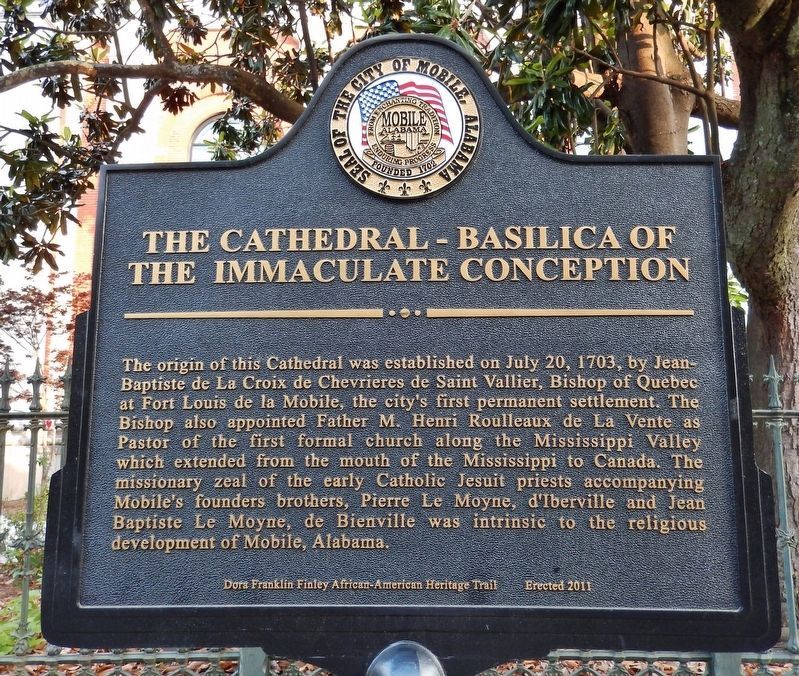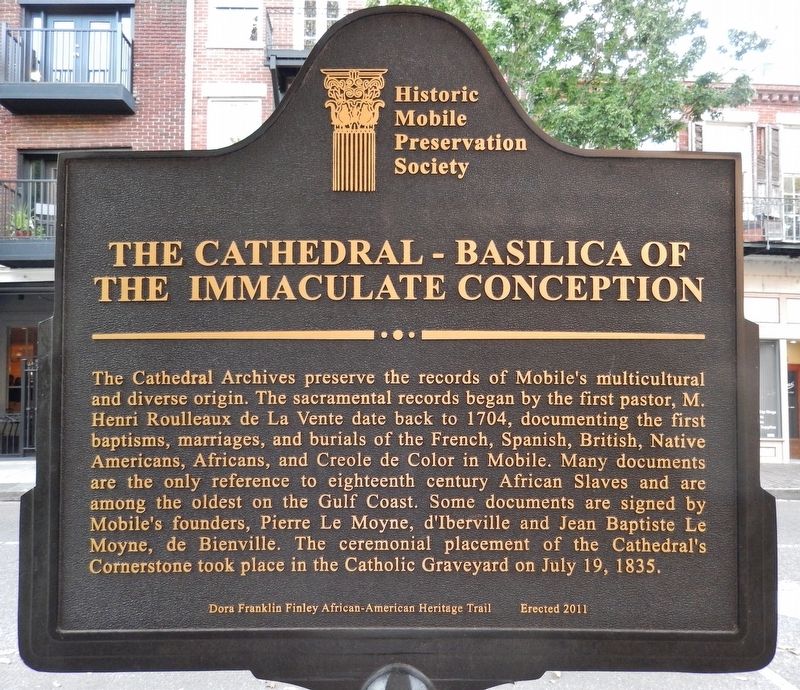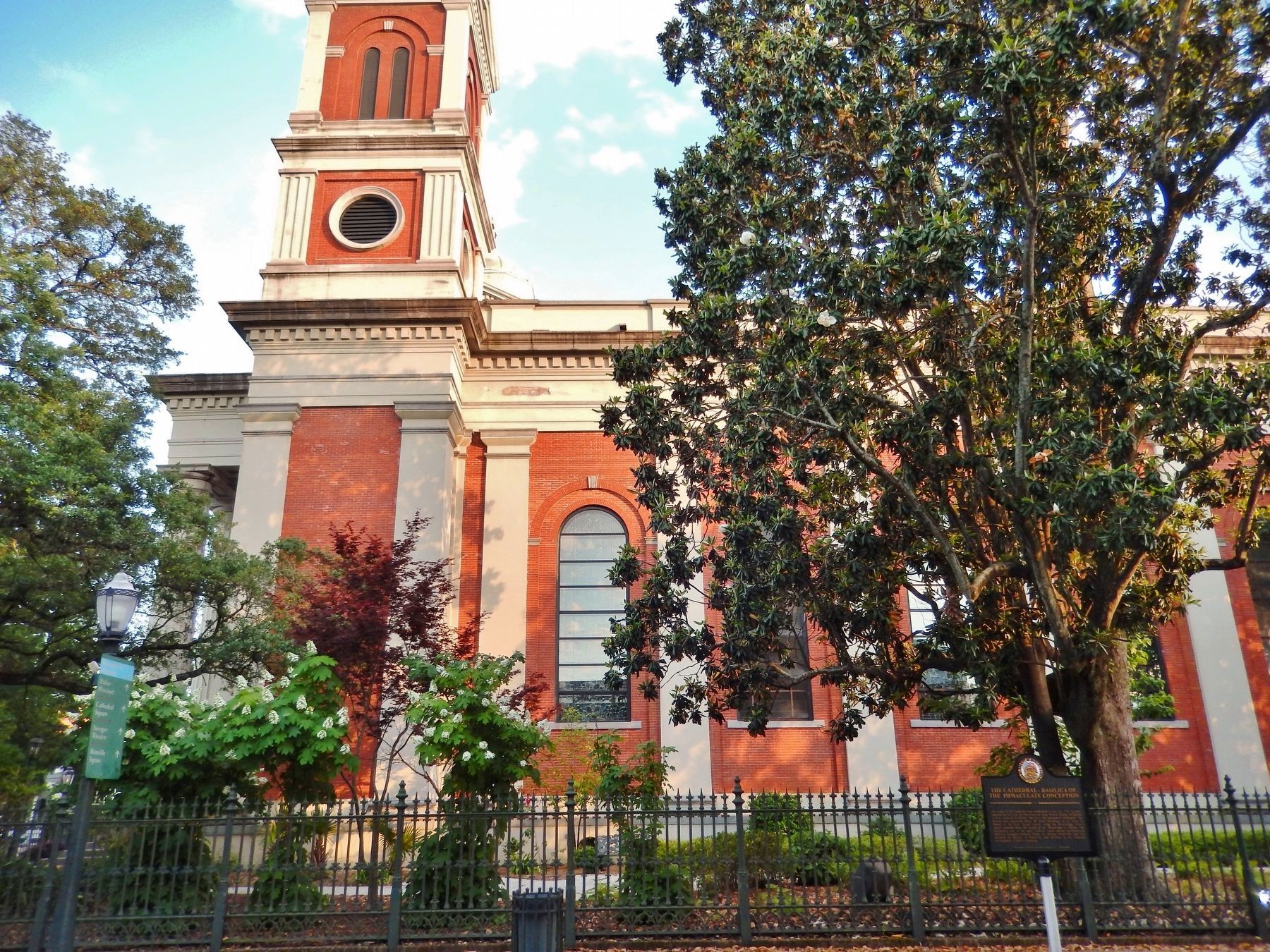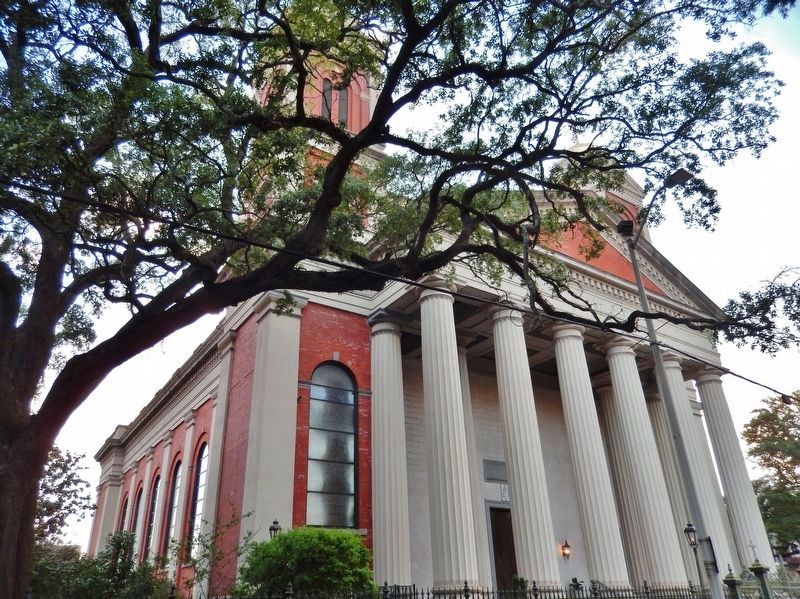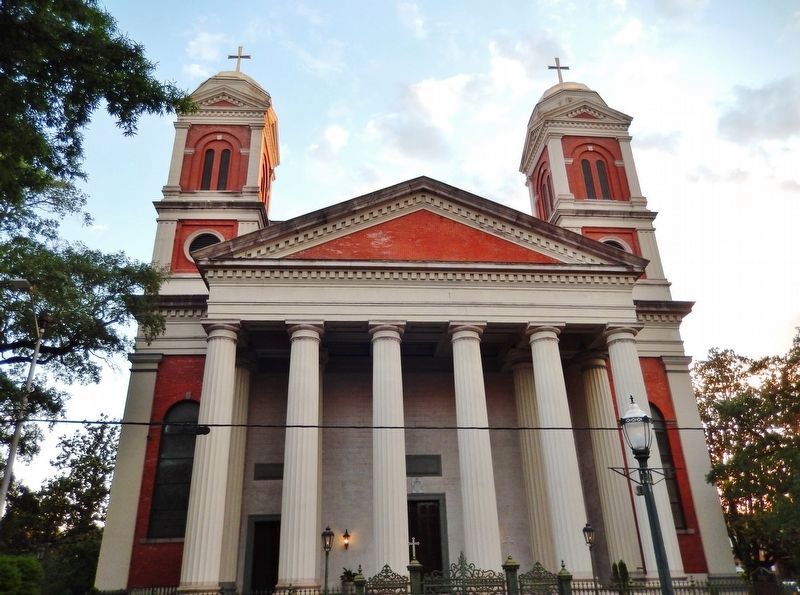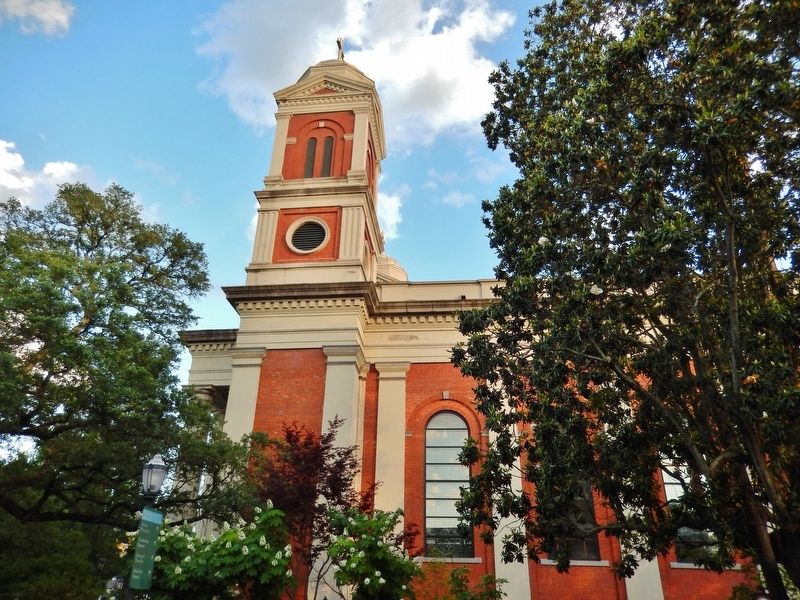Mobile in Mobile County, Alabama — The American South (East South Central)
The Cathedral-Basilica of the Immaculate Conception
Inscription.
(front side)
The origin of this Cathedral was established on July 20, 1703, by Jean-Baptiste de La Croix de Chevrieres de Saint Vallier, Bishop of Quebec at Fort Louis de la Mobile, the city’s first permanent settlement. The Bishop also appointed Father M. Henri Roulleaux de La Vente as Pastor of the first formal church along the Mississippi Valley which extended from the mouth of the Mississippi to Canada. The missionary zeal of the early Catholic Jesuit priests accompanying Mobile’s founders brothers, Pierre Le Moyne, d’Iberville and Jean Baptiste Le Moyne, de Bienville was intrinsic to the religious development of Mobile, Alabama.
(back side)
The Cathedral Archives preserve the records of Mobile’s multicultural and diverse origin. The sacramental records began by the first pastor, M. Henri Roulleaux de La Vente date back to 1704, documenting the first baptisms, marriages, and burials of the French, Spanish, British, Native Americans, Africans, and Creole de Color in Mobile. Many documents are the only reference to eighteenth century African Slaves and are among the oldest on the Gulf Coast. Some documents are signed by Mobile’s founders, Pierre Le Moyne, d’Iberville and Jean Baptiste Le Moyne, de Bienville. The ceremonial placement of the Cathedral’s Cornerstone took place in the Catholic Graveyard on July 19, 1835.
Erected 2011 by Historic Mobile Preservation Society and the Dora Franklin Finley African-American Heritage Trail. (Marker Number 3.)
Topics and series. This historical marker is listed in these topic lists: African Americans • Cemeteries & Burial Sites • Churches & Religion • Native Americans. In addition, it is included in the Dora Franklin Finley African-American Heritage Trail of Mobile series list. A significant historical date for this entry is July 20, 1703.
Location. 30° 41.425′ N, 88° 2.755′ W. Marker is in Mobile, Alabama, in Mobile County. Marker is on Dauphin Street west of South Claiborne Street, on the right when traveling east. Marker is located on the north side of the Cathedral. Touch for map. Marker is at or near this postal address: 2 S Claiborne St, Mobile AL 36602, United States of America. Touch for directions.
Other nearby markers. At least 8 other markers are within walking distance of this marker. Cathedral-Basilica of the Immaculate Conception / Archdiocese of Mobile (within shouting distance of this marker); It Takes a Village (within shouting distance of this marker); Portier House (about 300 feet away, measured in a direct line); 400 Government Street 1860 (about 600 feet away); Saenger Theatre (about 700 feet away); Wallace Turnage (about
700 feet away); Government Street Presbyterian Church (about 700 feet away); On this Spot Woodrow Wilson Said: (about 700 feet away). Touch for a list and map of all markers in Mobile.
Regarding The Cathedral-Basilica of the Immaculate Conception. National Register of Historic Places
Related markers. Click here for a list of markers that are related to this marker. Cathedral-Basilica of the Immaculate Conception
Also see . . .
1. Pierre Le Moyne d'Iberville. Britannica website entry:
In January 1699 Iberville explored the northern coast of the Gulf of Mexico, rediscovering the mouth of the Mississippi. Later he established a temporary fort, Fort Maurepas, on Biloxi Bay. The following year he established a second fort, Fort La Boulaye, just below present-day New Orleans and in 1702 constructed a new post, Fort St. Louis, on the Mobile River. The success of these defense projects persuaded Louis XIV to begin colonizing Louisiana. (Submitted on May 9, 2018, by Cosmos Mariner of Cape Canaveral, Florida.)
2. Jean-Baptiste Le Moyne de Bienville. Britanica website entry:
Jean-Baptiste was the eighth son of Canadian pioneer Charles Le Moyne. He entered the French navy at age 12 and served with his noted elder brother, Pierre Le Moyne d’Iberville.
A settlement was founded near the area of modern Biloxi in early 1699, and Bienville was made second in command of the colony when his brother departed in the spring. He explored the lower Mississippi and the Red River (1699–1700), and, when the colony’s leader, one “Sauvole,” died in 1701, Bienville was commissioned as commandant. In 1702 he moved the colony to Fort Louis on Mobile Bay, and in 1711 it was established at the present site of Mobile, Ala. (Submitted on May 9, 2018, by Cosmos Mariner of Cape Canaveral, Florida.)
3. Cathedral of the Immaculate Conception. Visit Mobile website entry:
The first Catholic Parish on the Gulf coast was established at Mobile in 1703, one year after the founding of Mobile. In 1704, Father Henri Roulleaux De la Vente was canonically installed as the first pastor of the Church of Fort Louis de la Louisiane (Mobile). When the City of Mobile was relocated to its present site in 1711, the Parish Church was rebuilt on the West side of Royal Street just North of Conti Street, under the patronage of Our Lady of Mobile. It was in 1781, in Mobile’s Spanish period, that the parish received its present title “Church of the Immaculate Conception.” (Submitted on May 9, 2018, by Cosmos Mariner of Cape Canaveral, Florida.)
Credits. This page was last revised on August 18, 2022. It was originally submitted on May 9, 2018, by Cosmos Mariner of Cape Canaveral, Florida. This page has been viewed 435 times since then and 38 times this year. Photos: 1, 2, 3, 4, 5, 6. submitted on May 9, 2018, by Cosmos Mariner of Cape Canaveral, Florida. • Bernard Fisher was the editor who published this page.
